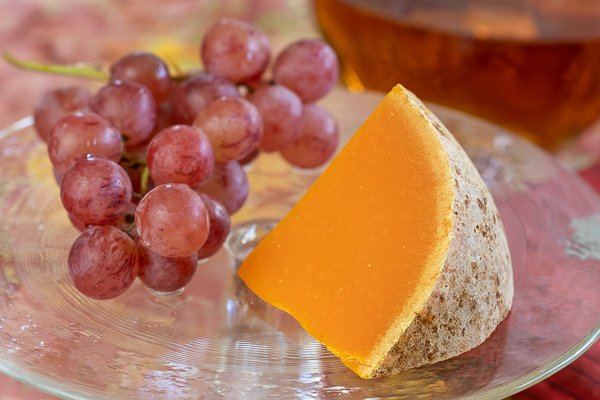I thought I knew why producers added color to cheese, giving some Goudas and Cheddars the hue of a Garnet yam. But I recently read more about the origins of this peculiar practice, and now I’m a little less sure of my facts. What’s certain is that Mimolette (above) without its screaming orange interior would be just another aged cheese and not the head turner it is. Wisconsin Cheddar without its trademark orange tint would look just like Vermont Cheddar. But if you’ve ever wondered what inspired cheesemakers to manipulate their products’ natural color, and why the tradition persists, here are some more or less believable stories.
First, some facts: Annatto, the colorant that produces the marigold hue, is totally natural. It’s the hard, brick-red seed of a small tree that grows in the tropics (Bixa orellana). In the Yucatán, the seed is called achiote and it’s added to seasoning pastes to give meat, fish and chicken a ruddy color. Sampled on its own, it has an earthy taste but the tiny amount used in cheese contributes no flavor.
One plausible theory about annatto use comes from Paul Kinstedt, a cheese historian and professor emeritus of food science at the University of Vermont. Kinstedt told Allison Aubrey of NPR that the practice dates from the 17th century, when English cheesemakers realized they could make more money by skimming the cream from their milk, churning it for butter, and making cheese with the skimmed milk.
October surprise: Jasper Hill Farm Scream Cheese
Alas, this reduced-fat cheese was suspiciously pale. The yellowish pigment beta-carotene—which cows get from grass—is fat soluble. Skim the cream from milk and the beta-carotene goes with the cream. So these greedy British cheesemakers turned to annatto to make their pallid cheeses darker. They were “trying to trick people,” said Kinstedt.
I had thought that the practice emerged from farmers trying to make their pale winter cheese resemble their golden summer cheese, a hue attributable to the cows’ pasture diet in spring and summer. Annatto evened out the seasonal color fluctuation and yielded winter wheels with an internal color consumers associated with quality. Not content with a little color, some producers ramped it up, settling on a hue that curds never attain naturally.
Chris Roelli of Roelli Cheese Haus in Wisconsin has a slightly more sinister take on the practice, which he says Wisconsin cheesemakers embraced in the early 1900s. “Cleanliness in those days wasn’t anywhere near today’s standards, and some of the (visual) defects caused by that could be masked by using color,” says Roelli. “That’s really where it got its start.”
Wisconsin Cheddars are dyed today for purely aesthetic reasons, says Roelli. Consumers expect it. He makes cheese curds twice a week, tinting the Friday batch but not the Tuesday batch. The orange curds outsell the pale version four to one.
I’m a little more skeptical about the lore behind Mimolette’s garish color. Historians trace the cheese’s origins to the Franco-Dutch War in the 1670s, making it one of France’s oldest cheeses. The war cut off trade between France and the Netherlands, depriving the French of the Edam they loved. So the French finance minister encouraged his countrymen to devise a knockoff. Patricia Michelson, a British cheesemonger and author of Cheese: The World’s Best Artisan Cheeses, writes that the orange color was “probably a snub at the Dutch royal House of Orange” and was initially produced with carrot juice.
Today, some cheesemakers use annatto to enhance rind color as well. It gives a salmon-colored tone to the exterior of Brebirousse d’Argental and Epoisses. Some Gouda producers use it; some don’t. Roelli’s Red Rock—a rinded Cheddar with blue veins—amps up the annatto and is the creamery’s top seller. Britain’s Sparkenhoe Red Leicester and Shropshire Blue also rely on annatto for their distinctive look.
Annatto helps cheeses stand out at a cheese counter. Some uses are gimmicky—Scream Cheese, anyone?—but employed more subtly, this little seed can add genuine aesthetic appeal.


